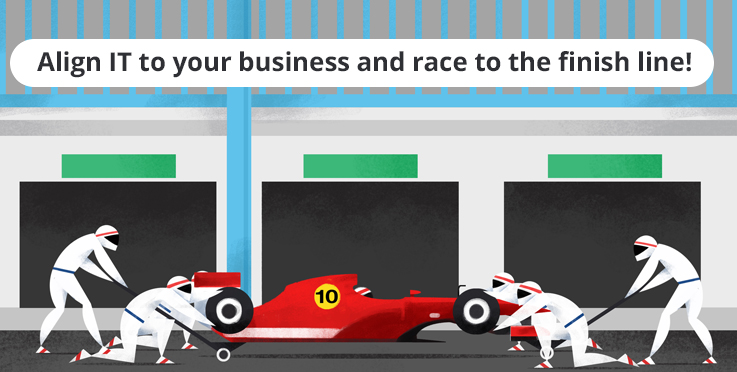Have you ever felt your car pull to the left or right when you wanted to go straight? You’d immediately know that the wheels must be realigned. Now, if your business were your car, your IT is undoubtedly the wheels. So if your business starts to underperform, it may be time to check your IT and business alignment.
Here are 10 key steps to aligning your IT and business and straightening things out.
- Have a dynamic CIO: You need a CIO who collaborates with top executives, analyzes market data and trends, and strategizes for the future. The CIO must invest in the right technologies that will power your company to win in the marketplace. This will help transform the way your company does business.
- Relay the IT story: A monthly newsletter that lets the entire organization know how IT is positively impacting business can do wonders. This will ensure that IT is rightly perceived as the heart (or wheels!) of your company. Over time, IT will be able to build stronger and mutually enriching relationships with other functions. In the process, the IT team will be motivated to work harder.
- Create brand equity through technology: Every successful brand makes certain promises to its customers. The IT team must be in a position to deliver on these promises every time. The IT service catalog, which is nothing but these promises documented, must be developed as a means to build brand equity. Moreover, the IT team must always work towards customer-specific goals.
- Be social to engage: Close to 35% of Americans say that social media has in some ways influenced their purchasing decision. JW Marriott Cancun Resort ran one of the best social media campaigns, generating media value of $378,280 and reaching 1.8 million people. IT and marketing should analyze where the target audience goes, the growth of different demographics in social media, and the percentage of customers accessing social media through mobile devices. You must be present at the right place to interact with your customers. A social media analytics tool that integrates with various social media platforms and gives a competitive analysis will also give intelligence.
- Improve productivity with mobile: Bring Your Own Device (BYOD) is powerful. In developed markets such as the U.S., U.K., and Germany, BYOD accounts for 21% of productivity gains. You must decide which employees get mobile access, what data they can access, and what type of devices can be used for access. Of course, in such instances, IT security and asset management become critical.
- Use big data to drill down to small things: The right data analytics tool can make a big difference. Southwest calls itself a customer service company that only happens to fly airplanes. It uses big data to uncover specific customer details and connect with each customer. The results are telling. The company is ranked as the best airline in customer service in the U.S. Big data can definitely increase operating margin by as much as 60%.
- Focus on the cloud: Netflix uses the cloud, so it can exclusively focus on its content. Superior content is the main reason Netflix accounts for 33% of all prime-time web traffic in North America. While a public cloud is low-cost and simple, it may also be less secure. A private cloud offers greater security and compliance, but it’s also more expensive. A small business may prefer the public cloud’s pay-as-you-go flexibility. A bank, on the other hand, may prefer the private cloud’s increased security. A hybrid cloud can be used by a company that has both sensitive and non-sensitive information. You can achieve up to 2.5 times more gross profit growth than your competitors by using the cloud.
- Show the ROI: The benefits (and costs) of IT projects must be quantified, and a business case must be presented before getting the go-ahead for the investment. The indirect gains due to increases in employee productivity, customer satisfaction, and collaboration must also be estimated while calculating the ROI.
- Move fast: You must move IT projects at fast pace to create business impact in the shortest possible time. You may also also gain competitive advantages from being an early adopter of technology. Project deadlines must be measured in days, not months.
- Eliminate the need for shadow IT: While shadow IT can lead to short-term benefits for departments that use it, it can also lead to inefficiencies, wasted time, and security risks. An integrated IT system can enable different departments to come together on a common platform and work towards success.
Align IT to Realize Your True Potential
In the coming years, it will be necessary for IT to stay ahead of business demands to win against competition. The IT team will need to know the pulse of the customers at every point in time. In this way, customer value can be maximized and your company can achieve its true potential.
